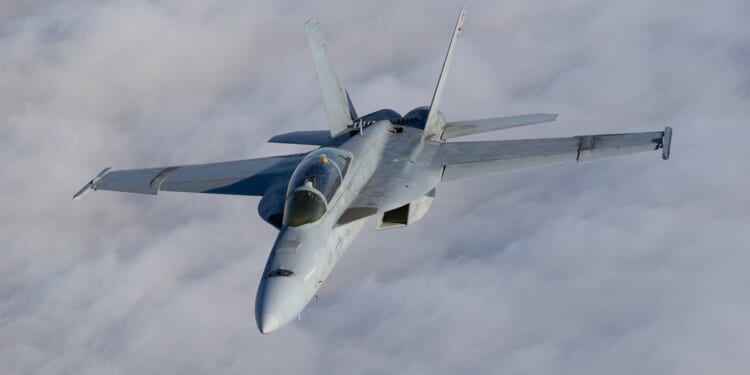It does not appear at first glance that the two crashes are directly linked. Instead, both aircraft seem to have crashed in part due to hostile weather.
Five United States Navy crewmembers were safe and in stable condition on Sunday evening following a pair of mishaps that occurred only 30 minutes apart in the South China Sea. A F/A-18F Super Hornet multirole fighter and a MH-60R Sea Hawk helicopter—both operating from the nuclear-powered supercarrier USS Nimitz (CVN-68)—crashed on Sunday afternoon local time.
According to a United States Pacific Fleet post on Facebook, each of the aircraft was conducting “routine operations” until approximately 2:45 pm local time, when the Sea Hawk from “Helicopter Maritime Strike Squadron (HSM) 73 ‘Battle Cats’… went down in the waters of the South China Sea.” Just 30 minutes later, at 3:15 pm, “an F/A-18F Super Hornet fighter assigned to the ‘Fighting Redcocks’ of Strike Fighter Squadron (VFA) 22,” also crashed into the sea.
Both the pilot and the weapons system officer (WSO) from the two-seat Super Hornet were able to eject safely.
“Search and rescue assets assigned to Carrier Strike Group 11” were quickly deployed, and all five personnel were safely recovered. “The cause of both incidents is currently under investigation,” the US Pacific Fleet added.
The United States Navy didn’t state what caused the crash, but other posts on social media noted that the South China Sea was experiencing isolated showers, with heavy rain falling in short bursts and strong wind gusts.
The F/A-18 Super Hornet’s Specifications
- Year Introduced: 1999
- Number Built: ~630
- Length: 60.1 ft (18.31 m)
- Height: 16 feet (4.88 m)
- Wingspan: 44.9 ft (13.62 m)
- Weight:
- Empty – 32,100 lb (14,552 kg)
- Maximum takeoff weight – 66,000 lb (29,937 kg)
- Engines: Two F414-GE-400 turbofan engines (13,000 lbf each dry, 22,000 lbf with afterburner)
- Top Speed: 1,030 knots (1,190 mph, 1,915 km/h) at altitude
- Range: 1,678 miles (2,700 km)
- Service Ceiling: 50,000 feet+ (~15,000 m)
- Loadout: A variety of air-to-air and air-to-ground weapons, as well as fuel tanks and targeting pods. Air-to-air loadouts include AIM-9 Sidewinders and AIM-120 AMRAAMs.
- Aircrew: 1-2, depending on variant
The F/A-18 Super Hornet Is Having a Very Bad Year
Sunday’s crash of an F/A-18 Super Hornet is the latest in a series of crashes that have now seen four of the carrier-based aircraft lost this year, while another was shot down in a friendly fire incident in the Middle East in December. In addition, two EA-18G Growlers, the electronic warfare (EW) variant of the F/A-18 Super Hornet, also crashed in just the past year.
Three of those Super Hornets were operating from the Norfolk-based USS Harry S. Truman (CVN-75). The first was shot down in a friendly fire incident in December. Shortly before Christmas 2024, the twin-engine, two-seat Super Hornet was mistakenly identified as a hostile missile and fired upon by the Ticonderoga-class guided-missile cruiser USS Gettysburg (CG-64), one of the warships in CVN-75’s carrier strike group (CSG). Fortunately, the pilots ejected safely and were quickly rescued.
In April and May, two other Super Hornets were lost while the supercarrier was operating in the Red Sea. The first of those two fell off the supercarrier while being towed to the hangar, reportedly while USS Harry S. Truman was maneuvering to avoid a Houthi attack. The second F/A-18 crashed into the Red Sea just weeks later, after a malfunction of its arrestment system, which is needed to slow the fighter as it lands on the flight deck. The pilot also ejected and was rescued.
In August, another F/A-18 Super Hornet crashed off the coast of Virginia during a routine training flight. That pilot was also rescued and taken to a local hospital for observation.
A pair of US Navy aviators was killed in October 2024 when their EA-18G Growler crashed near Washington state’s Mount Rainier while taking off during a training flight. Two other aviators suffered injuries when their EA-18 went down in San Diego Harbor in February of this year.
Each F/A-18 Super Hornet and Growler variant has a price tag of around $67 million.
An MH-60R Sea Hawk Was Also Lost
The MH-60R Sea Hawk, a naval variant of the Black Hawk helicopter, has a good safety record. The last reported incident involving an MH-60R was in January 2024, when one went down in San Diego Bay, during a training flight. All six crewmembers were rescued.
A Royal Australian Navy Sea Hawk also crashed in October 2021, with all of its crew safely rescued.
About the Author: Peter Suciu
Peter Suciu has contributed over 3,200 published pieces to more than four dozen magazines and websites over a 30-year career in journalism. He regularly writes about military hardware, firearms history, cybersecurity, politics, and international affairs. Peter is also a contributing writer for Forbes and Clearance Jobs. He is based in Michigan. You can follow him on Twitter: @PeterSuciu. You can email the author: Five US Navy Crewmen Safe After Twin Aircraft Mishaps on Sunday
It does not appear at first glance that the two crashes are directly linked. Instead, both aircraft seem to have crashed in part due to extremely hostile weather.
Five United States Navy crewmembers were safe and in stable condition on Sunday evening following a pair of mishaps that occurred only 30 minutes apart in the South China Sea. A F/A-18F Super Hornet multirole fighter and a MH-60R Sea Hawk helicopter—both operating from the nuclear-powered supercarrier USS Nimitz (CVN-68)—crashed on Sunday afternoon local time.
According to a United States Pacific Fleet post on Facebook, each of the aircraft was conducting “routine operations” until approximately 2:45 pm local time, when the Sea Hawk from “Helicopter Maritime Strike Squadron (HSM) 73 ‘Battle Cats’… went down in the waters of the South China Sea.” Just 30 minutes later, at 3:15 pm, “an F/A-18F Super Hornet fighter assigned to the ‘Fighting Redcocks’ of Strike Fighter Squadron (VFA) 22,” also crashed into the sea.
Both the pilot and the weapons system officer (WSO) from the two-seat Super Hornet were able to eject safely.
“Search and rescue assets assigned to Carrier Strike Group 11” were quickly deployed, and all five personnel were safely recovered. “The cause of both incidents is currently under investigation,” the US Pacific Fleet added.
The United States Navy didn’t state what caused the crash, but other posts on social media noted that the South China Sea was experiencing isolated showers, with heavy rain falling in short bursts and strong wind gusts.
The F/A-18 Super Hornet’s Specifications
- Year Introduced: 1999
- Number Built: ~630
- Length: 60.1 ft (18.31 m)
- Height: 16 feet (4.88 m)
- Wingspan: 44.9 ft (13.62 m)
- Weight:
- Empty – 32,100 lb (14,552 kg)
- Maximum takeoff weight – 66,000 lb (29,937 kg)
- Engines: Two F414-GE-400 turbofan engines (13,000 lbf each dry, 22,000 lbf with afterburner)
- Top Speed: 1,030 knots (1,190 mph, 1,915 km/h) at altitude
- Range: 1,678 miles (2,700 km)
- Service Ceiling: 50,000 feet+ (~15,000 m)
- Loadout: A variety of air-to-air and air-to-ground weapons, as well as fuel tanks and targeting pods. Air-to-air loadouts include AIM-9 Sidewinders and AIM-120 AMRAAMs.
- Aircrew: 1-2, depending on variant
The F/A-18 Super Hornet Is Having a Very Bad Year
Sunday’s crash of an F/A-18 Super Hornet is the latest in a series of crashes that have now seen four of the carrier-based aircraft lost this year, while another was shot down in a friendly fire incident in the Middle East in December. In addition, two EA-18G Growlers, the electronic warfare (EW) variant of the F/A-18 Super Hornet, also crashed in just the past year.
Three of those Super Hornets were operating from the Norfolk-based USS Harry S. Truman (CVN-75). The first was shot down in a friendly fire incident in December. Shortly before Christmas 2024, the twin-engine, two-seat Super Hornet was mistakenly identified as a hostile missile and fired upon by the Ticonderoga-class guided-missile cruiser USS Gettysburg (CG-64), one of the warships in CVN-75’s carrier strike group (CSG). Fortunately, the pilots ejected safely and were quickly rescued.
In April and May, two other Super Hornets were lost while the supercarrier was operating in the Red Sea. The first of those two fell off the supercarrier while being towed to the hangar, reportedly while USS Harry S. Truman was maneuvering to avoid a Houthi attack. The second F/A-18 crashed into the Red Sea just weeks later, after a malfunction of its arrestment system, which is needed to slow the fighter as it lands on the flight deck. The pilot also ejected and was rescued.
In August, another F/A-18 Super Hornet crashed off the coast of Virginia during a routine training flight. That pilot was also rescued and taken to a local hospital for observation.
A pair of US Navy aviators was killed in October 2024 when their EA-18G Growler crashed near Washington state’s Mount Rainier while taking off during a training flight. Two other aviators suffered injuries when their EA-18 went down in San Diego Harbor in February of this year.
Each F/A-18 Super Hornet and Growler variant has a price tag of around $67 million.
An MH-60R Sea Hawk Was Also Lost
The MH-60R Sea Hawk, a naval variant of the Black Hawk helicopter, has a good safety record. The last reported incident involving an MH-60R was in January 2024, when one went down in San Diego Bay, during a training flight. All six crewmembers were rescued.
A Royal Australian Navy Sea Hawk also crashed in October 2021, with all of its crew safely rescued.
About the Author: Peter Suciu
Peter Suciu has contributed over 3,200 published pieces to more than four dozen magazines and websites over a 30-year career in journalism. He regularly writes about military hardware, firearms history, cybersecurity, politics, and international affairs. Peter is also a contributing writer for Forbes and Clearance Jobs. He is based in Michigan. You can follow him on Twitter: @PeterSuciu. You can email the author: [email protected].
Image: Shutterstock / ranchorunner.

















